In this review article, I will review 13 best lenses for sports photography for Canon and Nikon Cameras in 2020.
In addition, I will provide an actionable Buyers Guide on choosing the best lenses for sports photography based on your budget and specific needs, irrespective of your camera brand..
In a hurry?
Here are my suggestions but make sure to read the entire article including the Buyers Guide:
Best Lenses for Professional Sports Photography:
Canon EF 400 mm f/2.8L IS II USM
Nikon AF-S NIKKOR 300 mm f/2.8G ED VR II
Best Sports Lenses on a Budget:
Canon EF 70-200 mm f/2.8L USM
Nikon AF-S NIKKOR 70-200 mm f/2.8E FL ED VR
Best Sports Lenses for Mirrorless Cameras:
Canon EF-M 18-55 mm f3.5-5.6 IS STM
Nikon 1 NIKKOR 30-110 mm f/3.8-5.6 VR
Choosing the ideal lens for sports photography could be a struggle.
Nowadays, there are literally hundreds of lenses in the market for sports photography that you can choose from.
And there are many questions that need to be answered when choosing a lens for your specific camera such as Canon, Nikon, Sony, etc.:
- Is this lens compatible with my camera?
- What is the best focal length for doing sports photography with my camera?
- How close can this lens zoom to an athlete or object?
and so on…
Buying a good lens could be the biggest expense you would pay to start sports photography as a profession or just fun. Therefore, you must be extremely careful before buying.
What follows are detailed, unbiased reviews for the 13 best lenses for sports photography for Canon and Nikon cameras in 2020.
A comprehensive Buying Guide is also provided at the end to help you choose best lenses for sports photography for any cameras.
It also explains any terminology and features of the lenses that might be unfamiliar to you.
Also, make sure to check our latest article on best lenses for wildlife photography as the lens’s requirements have many similarities with sports photography.
Without further ado, let’s dive right in.
What Are the Best Lenses for Sports Photography (Canon & Nikon) in 2020?
Quick Answer:
- Canon EF 400 mm f/2.8L IS II USM Lens
- Canon EF 70-200 mm f/2.8L USM Lens
- Canon EF 24-70 mm f/2.8L II USM Lens
- Canon 200 mm f/2L IS Telephoto Lens
- Canon EF 100-400 mm f/4.5-5.6L IS II USM Lens
- Canon EF-M 18-55 mm f/3.5-5.6 IS STM Lens
- Nikon AF-S NIKKOR 200-400 mm f/4G ED VR II Lens
- Nikon AF-S NIKKOR 70-200 mm f/2.8E FL ED VR Lens
- Nikon AF-S NIKKOR 24-70 mm f/2.8E ED VR Lens
- Nikon 80-200 mm f/2.8 D ED AF Zoom Lens
- Nikon AF-S NIKKOR 300 mm f/2.8G ED VR II Lens
- Nikon 1 NIKKOR 30-110 mm f/3.8-5.6 VR Lens
- Nikon AF-S NIKKOR 80-400 mm f/4.5-5.6G ED VR Lens
Comparison Table for the Best Lenses for Sports Photography
| Camera Lens | Weight (lbs) | Maximum Aperture | Maximum Focal Length (mm) | Minimum Focal Length (mm) | Vibration Reduction | Year Introduced | ||
|---|---|---|---|---|---|---|---|---|
| Canon EF 400 mm f/2.8L IS II USM Lens | 8.49 | f/2.8 | 400 | 400 | 4 shutter speed stops | 2011 | ||
| Canon EF 70-200 mm f/2.8L USM Lens | 2.89 | f/2.8 | 200 | 70 | None | 1995 | ||
| Canon EF 24-70 mm f/2.8L II USM Lens | 1.77 | f/2.8 | 70 | 24 | None | 2012 | ||
| Canon 200 mm f/2L IS Telephoto Lens | 5.55 | f/2.0 | 200 | 200 | 4 shutter speed stops | 2008 | ||
| Canon EF 100-400 mm f/4.5-5.6L IS II USM Lens | 5.25 | f/4.5-5.6 | 400 | 100 | 4 shutter speed stops | 2014 | ||
| Canon EF-M 18-55 mm f/3.5-5.6 IS STM Lens | 0.46 | f/3.5-5.6 | 55 | 18 | 4 shutter speed stops | 2012 | ||
| Nikon AF-S NIKKOR 200-400 mm f/4G ED VR II Lens | 7.41 | f/4.0 | 400 | 200 | 4 shutter speed stops | 2010 | ||
| Nikon AF-S NIKKOR 70-200 mm f/2.8E FL ED VR Lens | 3.15 | f/2.8 | 200 | 70 | 4 shutter speed stops | 2016 | ||
| Nikon AF-S NIKKOR 24-70 mm f/2.8E ED VR Lens | 2.4 | f/2.8 | 70 | 24 | 4 shutter speed stops | 2015 | ||
| Nikon 80-200 mm f/2.8 D ED AF Zoom Lens | 2.86 | f/2.8 | 200 | 80 | None | 1997 | ||
| Nikon AF-S NIKKOR 300 mm f/2.8G ED VR II Lens | 3.17 | f/2.8 | 300 | 300 | 4 shutter speed stops | 2000 | ||
| Nikon 1 NIKKOR 30-110 mm f/3.8-5.6 VR Lens | 0.39 | f/3.8-5.6 | 110 | 30 | 3 shutter speed stops | 2011 | ||
| Nikon AF-S NIKKOR 80-400 mm f/4.5-5.6G ED VR Lens | 3.46 | f/4.5-5.6 | 400 | 80 | 4 shutter speed stops | 2013 | ||
Best Canon Lenses for Sports Photography in 2020
1. Canon EF 400 mm f/2.8L IS II USM Lens
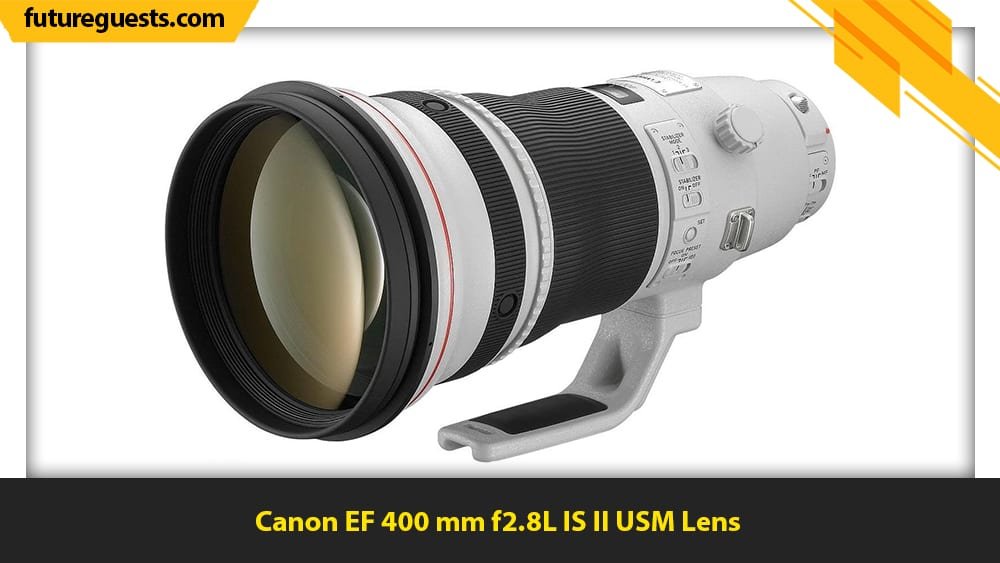
if you are NOT on a tight budget, Canon EF 400 mm f/2.8L IS II USM is one of the best lenses for sports photography.
It is designed for full-frame Canon EF-mount DSLRs. It is also compatible with APS-C camera models providing an equivalent of 640 mm focal length.
It weighs 8.49 lbs, which is relatively heavy compared to the other lenses suitable for sports photography.
Having a dimension of 163 × 461 mm, it is also relatively large in size and not easily portable.
This lens first became available in the market in 2011.
Features & Benefits:
- With a maximum aperture of f/2.8, this L-series lens is suitable for outdoor and sports photography. This aperture gives you a nice control over depth of field.
This means you can make the background looks really blur in order to focus on an object. It is also really helpful when working in poor lighting conditions. - This lens has two fluorite elements in its optical design, which help decrease the chromatic aberrations for higher image quality.
- Flare and ghosting are reduced by applying Sub Wavelength Coating (SWC) to individual elements.
- In order to reduce shake, it consists of an advanced image stabilization system, which is able to reduce shake up to four shutter speed stops.
Moreover, this image stabilization system has three separate stabilization modes for different applications. - Fast, quiet and accurate autofocusing is made practical by means of ring-type Ultrasonic Motor (USM). Additionally, it has full-time manual focus override feature to incorporate your focusing preferences.
- Dust- and water-resistant enabling shooting in bad weather conditions.
Pros
- Really fast autofocus performance
- Minimal chromatic aberration
- Ultra high-quality images
- Creating nicely blurred backgrounds
Cons
- Relatively expensive
- Not easily portable due to its dimension
- Not easily handholdable for a long period of time
2. Canon EF 70-200 mm f/2.8L USM Lens
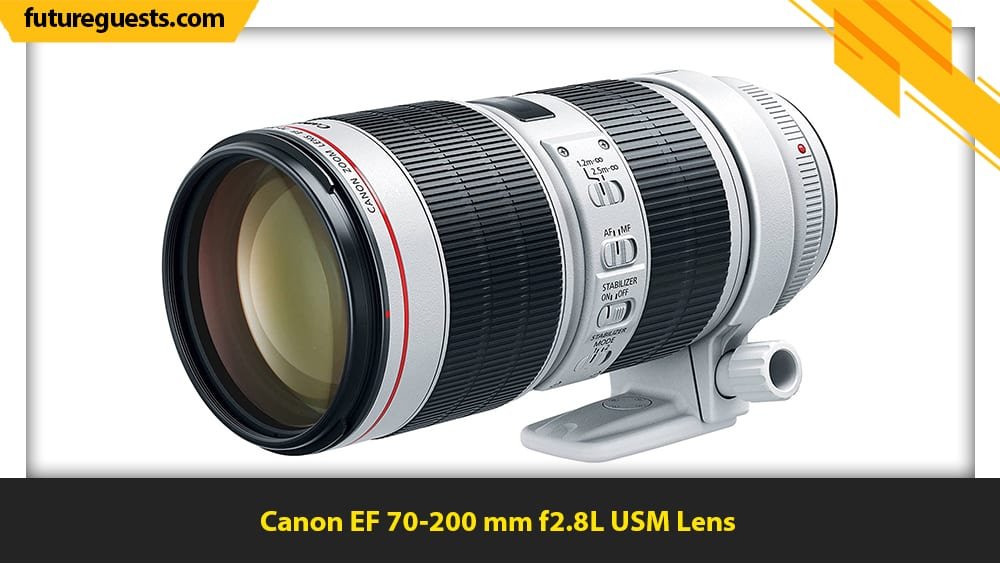
This is a truly versatile telephoto zoom lens, which is able to meet the various needs of many photographers.
The Canon EF 70-200 mm f/2.8L USM lens is designed for use with full-frame Canon EF-mount DSLRs. It can also be used with APS-C camera models. In such condition, it will provide an equivalent focal length of 112-320 mm.
Weighing only 2.89 lbs, it is considered really light weight. The diameter and length of this lens are 85 mm and 194 mm, respectively.
Despite being first introduced in 1995, it has still remained very popular.
You must be aware that it has no image stabilization system. Therefore, perhaps mounting it on a tripod or monopod will be a better choice.
Canon EF 70-200 mm f/2.8L USM is one of the best lenses for sports photography due to many of its features:
Features & Benefits:
- By taking the advantage of the maximum aperture of f/2.8, you can easily control depth of field and use this lens in bad lighting conditions.
- It covers a wide range of focal lengths that enables shooting in both portrait-length and medium tele range.
- Four Ultra-Low Dispersion (UD) elements have been incorporated in its design to minimize chromatic aberrations and color fringing for higher image clarity.
- Flare and ghosting are reduced by applying Super Spectra coating to elements.
- A ring-type Ultrasonic Motor enables fast and quiet autofocusing. Individual preferences can be applied to this autofocusing performance by using the full-time manual focus override feature.
- A removable rotating tripod collar in structure of this lens, makes it easier for use on top of a tripod.
- Dust- and water sealed for use in bad weather conditions.
- This lens can be used with EF 1.4X and EF 2X teleconverters to maximize its reach.
Pros
- Ultra-fast autofocus performance
- Minimized chromatic aberration
- Light weight
- Creating beautifully blurred backgrounds
Cons
- No image stabilization system for reducing shake
Expert Opinion:
3. Canon EF 24-70 mm f/2.8L II USM Lens
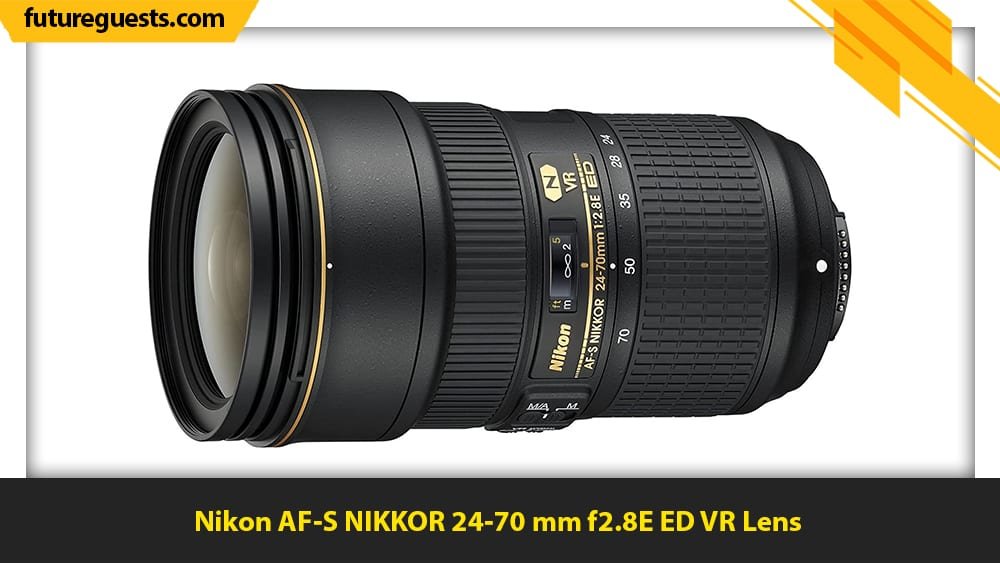
EF 24-70mm f/2.8L II USM is one of the best Canon’s L-series lenses that can be used for a variety of applications due to its varying focal length.
It is designed for full-frame Canon EF-mount DSLRs. Using it with APS-C camera models is also possible; however, this would provide an equivalent focal length of 38.4-112 mm.
This lens has no image stabilization system to reduce shake.
Its dimension is 88.5 x 113 mm and weighs only 1.77 lbs.
This lens first became available in the market in 2012.
Features & Benefits:
- Due to its maximum aperture of f/2.8, you can easily control the depth of field to create beautifully blurred backgrounds. It also makes it easier to take high-quality images in bad lighting conditions.
- Color fringing and chromatic aberrations are reduced by incorporation of one Super Ultra-Low Dispersion element and two Ultra-Low Dispersion elements.
- Also, by using three aspherical elements, image sharpness is increased and distortion is decreased.
- Flare and ghosting are reduced by providing Super Spectra coating for each element.
- By using a ring-type Ultrasonic Motor in its structure, it can autofocus quietly at a very high speed. The manual focus override option gives control to incorporate individual focus preferences in focus position.
- It is weather-resistant and can be used in bad weather conditions.
Pros
- Ultra-sharp images
- Fast and quiet autofocusing
- Minimized chromatic aberration
- Light weight
- Creating beautifully blurred backgrounds
Cons
- No image stabilization system for reducing shake
- Clarity issues in close ranges
Expert Opinion:
4. Canon 200 mm f/2L IS Telephoto Lens


The Canon 200 mm f/2L IS Telephoto lens is ideal for sports photography for many reasons.
It could specifically be used for indoor sports photography.
It is designed for full-frame Canon EF-mount DSLRs. It also works on APS-C with an equivalent 320 mm focal length.
Its dimension is 128 x 208 mm and weighs 5.55 lbs.
This lens became first available in 2008.
Features & Benefits:
- The maximum aperture of f/2L gives a lot of control over depth of field to produce beautifully blurred backgrounds. This is also really helpful for creating high-quality images in bad lighting conditions.
- The optical system of this lens consists of Ultra-Low Dispersion glass and fluorite elements for reducing chromatic aberrations.
- Super Spectra coating is also applied to the elements to reduce flare and ghosting.
- The image stabilizing system of this lens is able to reduce shake up to four shutter speed stops. This enables handhold shooting with sharper images.
- The ring-type Ultrasonic Motor and internal focusing mechanism allow for fast and quiet autofocusing performance. You can also incorporate your preferences in the focus position by taking the advantage of manual focus override option. This lens has also a focus preset option that can recall a programmed focusing position.
- You can use this lens with both EF 1.4X and EF 2X teleconverters to increase lens reach.
Pros
- Ultra-sharp images
- Fast and quiet autofocusing
- Great image stabilization system
- Creating beautifully blurred backgrounds
Cons
- Expensive
- A bit heavy for long period handholding
Expert Opinion:
5. Canon EF 100-400 mm f/4.5-5.6L IS II USM Lens
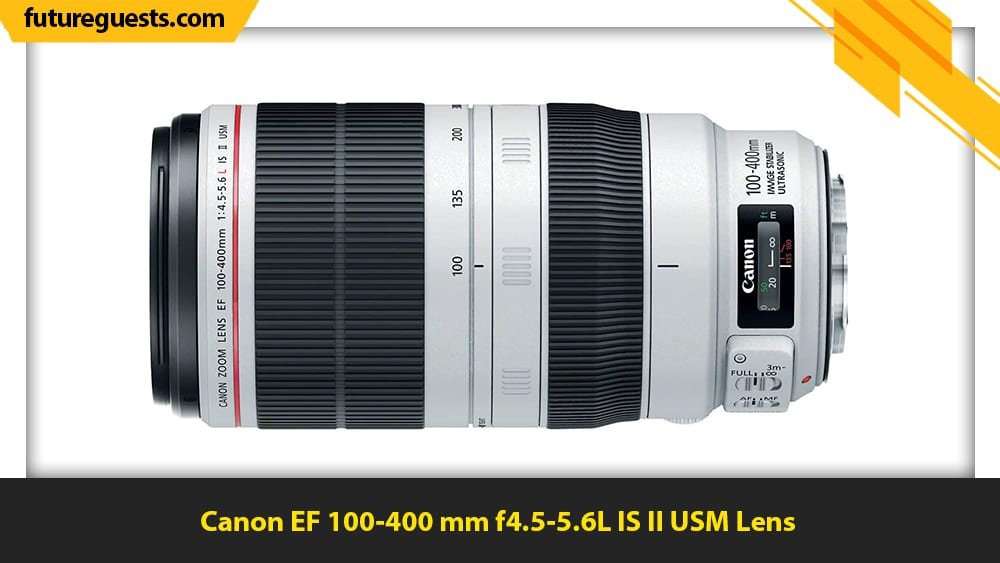

Another lens choice for shooting great photos in sports photography would be the Canon EF 100-400 mm f/4.5-5.6L IS II USM.
This long-reaching L-series lens has great optical design and image stabilization system.
The Canon EF 100-400 mm f/4.5-5.6L IS II USM lens is designed for full-frame EF-mount DSLRs. However, it works fine with APS-C camera models as well providing an equivalent focal length of 640 mm.
Its diameter and length are 94 mm and 193 mm, respectively. It weighs 5.25 lbs and it was first introduced in 2014.
Features & Benefits:
- Inside the optical structure, one Super Ultra-Low Dispersion element and one fluorite element are utilized to minimize chromatic aberrations and color fringing throughout the zoom range.
- Flare and ghosting are reduced by applying Air Sphere Coating to individual elements.
- The image stabilization system of this lens is able to reduce shake up to four shutter speed stops. This enables handhold shooting with high image clarity and sharpness.
- The ring-type Ultrasonic Motor makes fast and quiet autofocusing practical.
- Fluorine coatings have been applied to the front and rear elements, which prevents sticking of surface residues and makes cleaning of the lens easier.
- Highly resistant to dust and water facilitating its use in harsh weather conditions.
- As a specific feature, it consists of an ET-83D lens hood, which provides a side window for adjustment of the rotating filters without the need to remove the hood.
Pros
- Adjustable torque ring
- Multiple usability enhancements
- Fast and quiet autofocusing
- Great image stabilization system
Cons
- Loss of contrast against bright light
- Focusing problems when used with some of the teleconverters
Expert Opinion:
6. Canon EF-M 18-55 mm f/3.5-5.6 IS STM Lens
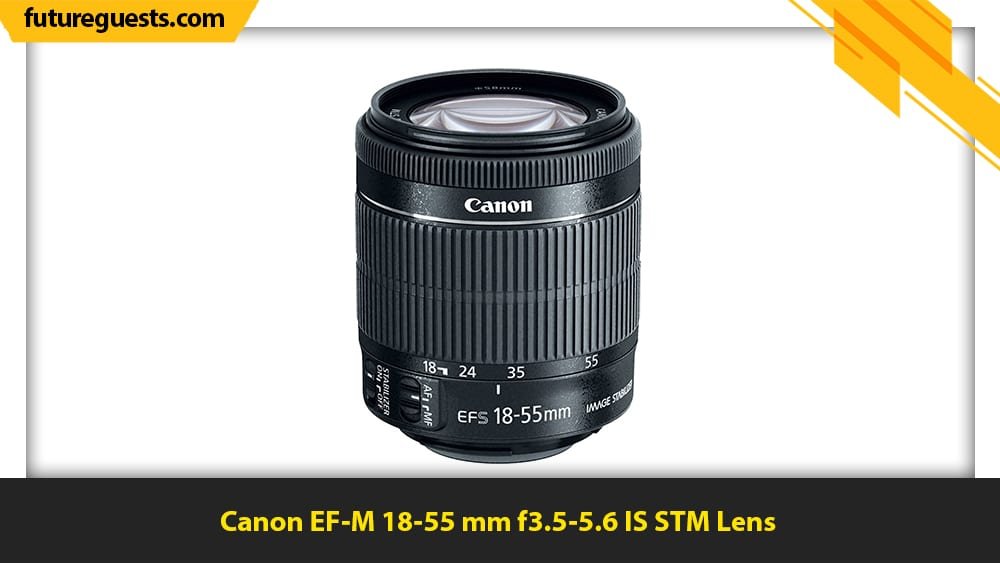

The Canon EF-M 18-55mm f/3.5-5.6 IS STM would be an ideal lens for sports photography if you have a mirrorless Canon camera. It is specifically designed for mirrorless cameras with a minimum focusing distance of 9.8 ft.
This lens is really compact and lightweight. The diameter and length of this lens are 60.9 mm and 61 mm, respectively and weighs only 0.46 lbs.
Note that this lens has no weather sealing, so I suggest not to use this lens in harsh weather conditions.
The lens was first introduced in 2012.
Features & Benefits:
- Consisting of a “seven blade circular aperture”, it can deliver soft backgrounds with great image quality.
- Ghosting and flare are reduced by coatings applied to the elements.
- Chromatic aberrations are reduced throughout the zoom range by utilizing three aspherical elements.
- The Movie Servo autofocus system of this lens consists of a stepping motor, which enables smooth and quiet autofocusing.
- The advanced image stabilization system could reduce shake up to four shutter speed stops. This feature makes this lens ideal for handhold shooting.
Pros
- Really compact
- Really lightweight and handholdable for long periods of time
- Excellent image stabilization system
- Very reasonable price
Cons
- No weather sealing
- Sharpness issues at the end of the zoom range
Expert Opinion:
Best Nikon Lenses for Sports Photography in 2020
7. Nikon AF-S NIKKOR 200-400 mm f/4G ED VR II Lens
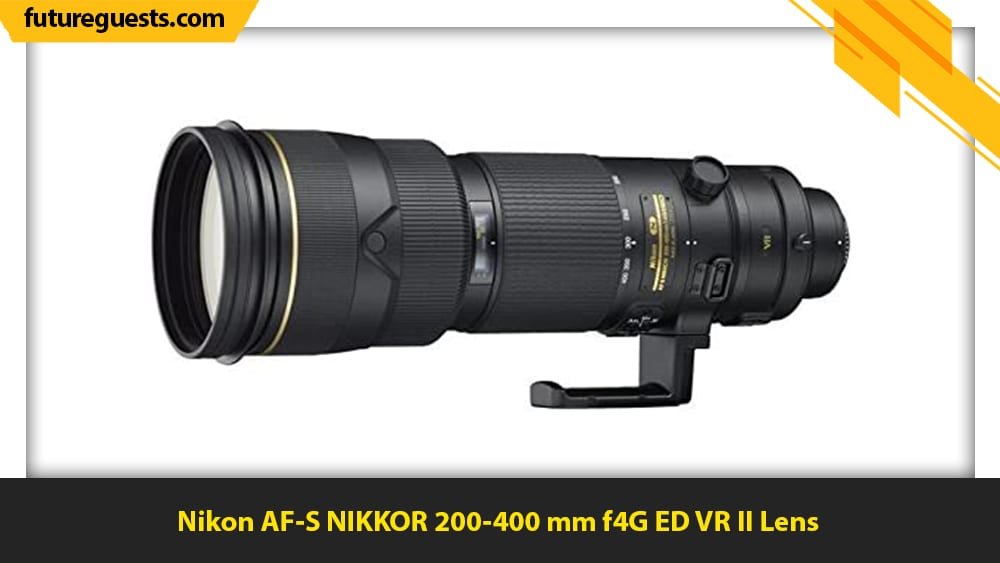

The Nikon AF-S NIKKOR 200-400 mm f/4G ED VR II is another best lens for sports photography due to its versatile focal length.
It is designed for FX-format F-mount cameras. It is also compatible with DX-format camera models. The equivalent focal length on DX models is 300-600 mm.
The dimension of this lens is 124 × 365 mm and it weighs 7.41 lbs. Therefore, this lens couldn’t be handheld for a long period.
It first became available in the market in 2010.
Features & Benefits:
- The maximum aperture of f/4 allowing consistent illumination throughout the zoom range.
- Four Extra-Low Dispersion elements to minimize chromatic aberrations and distortions to a large degree. This delivers beautifully sharp images with minimal color fringing.
- Nano Crystal and Super Integrated coatings applied to individual elements to reduce flare and ghosting and provide better color contrast in bad lighting conditions.
- Fast and quiet auto focusing is made viable using a Silent Wave Motor.
- The advanced image stabilization system of this lens is able to reduce shake up to four shutter speed stops. This enables efficient handhold shooting with sharp images.
- Could be used on top of a tripod or monopod by taking advantage of a rotating tripod collar.
- It also has sealings for protection against dust and moisture.
Pros
- Superb image quality
- Excellent image stabilization system
- Really fast and quiet autofocusing performance
Cons
- Relatively heavy
- Not easily portable due to its dimension
- Expensive
Expert Opinion:
8. Nikon AF-S NIKKOR 70-200 mm f/2.8E FL ED VR Lens


The versatile focal length of Nikon AF-S NIKKOR 70-200 mm f/2.8E FL ED VR makes it one of the best lenses for sports photography.
The Nikon AF-S NIKKOR 70-200 mm f/2.8E FL ED VR lens is designed for FX-format F-mount cameras. It can be used with DX-format cameras as well. With Dx-format cameras the equivalent focal length is 70-200 mm.
The dimension of this lens is 88.5 × 202.5 mm and weighs 3.15 lbs.
It was first introduced in 2016.
Features & Benefits:
- The maximum aperture of f/2.8 providing excellent control over depth of field. It could be used to produce beautifully blurred backgrounds while focusing on the main object. Furthermore, this aperture could help to produce sharp images in poor lighting conditions.
- Ultra-high image quality due to six Extra-Low Dispersion elements leading to reduced chromatic aberrations.
- One fluorite element and one high refractive index element are incorporated in its optical design for decreasing color fringing and delivering super-sharp images.
- Reduced Flare and ghosting by Nano Crystal and Super Integrated coatings, which have been applied to individual elements.
- Fluorine coatings applied to the front and rear elements to keep sticking of surface residues to minimum.
- Advanced vibration reduction and image stabilization technology, which can reduce shake up to four shutter speed stops and enables handhold shooting with sharper images.
- Fast, quiet and smooth autofocusing performance due to Silent Wave Motor technology used in the autofocus system. It has four focus buttons, which include AF lock and manual focus override options as well.
- Dust- and water-resistance enabling shooting in bad weather conditions.
Pros
- Ultra-high image quality
- Excellent image stabilization system
- Really fast and quiet autofocusing performance
Cons
- Sharpness issues at the edges near maximum and minimum focal length
Expert Opinion:
9. Nikon AF-S NIKKOR 24-70 mm f/2.8E ED VR Lens



The Nikon AF-S NIKKOR 24-70 mm f/2.8E ED VR short telephoto lens is an excellent choice for sports photography due to its highly advanced optical design, versatile focal length and maximum aperture of f/2.8.
Its optical design consists of a unique aspherical Extra-Low Dispersion element. Moreover, three additional aspherical elements, two other Extra-Low Dispersion elements and one high refractive index element have been incorporated to its design.
The Nikon AF-S NIKKOR 24-70 mm f/2.8E ED VR lens is specifically made for FX-format Nikon F-mount cameras. It also works fined with DX camera models providing an equivalent focal length of 36-105 mm.
Since the aperture mechanism of this lens is electromagnetic, the capability of this lens is limited to some camera models.
The lens dimension is 88 × 154.5 mm and it weighs 2.4 lbs.
It was first announced in August 2015.
Features & Benefits:
- The maximum aperture of f/2.8 provides a lot of control over depth of field and allows taking sharp photos in bad lighting situations.
- Minimized chromatic aberrations, distortions and color fringing due to highly advanced optical design.
- Nano Crystal and Super Integrated Coatings that have been applied to individual elements help reduce flare and ghosting.
- Fluorine coatings applied to the front and rear elements keep sticking of surface residues to minimum.
- Quick and quiet autofocusing is made viable using Silent Wave Motor technology inside the autofocusing system.
- Manual focus override option gives you the possibility to integrate your own focusing preferences to the focus position.
- The image stabilization system of this lens has the capability to reduce shake up to four shutter speed stops. This enables taking sharp photos while handholding the camera.
- This lens is totally sealed against dust and water for use in harsh weather conditions.
Pros
- Ultra-high image quality with minimal distortions
- Excellent image stabilization system
- Handholdable due to light weight
- Really fast and quiet autofocusing performance
Cons
- Compatibility with only some camera models
- Relatively expensive
Expert Opinion:
10. Nikon 80-200 mm f/2.8 D ED AF Zoom Lens



If you are looking for a fast and flexible lens for sports photography, then you should go for Nikon 80-200 mm f/2.8 D ED AF Zoom lens.
The focal length range of this lens covers portrait-length to medium telephoto ranges. It also provides a lot of benefits in poor lighting situations.
Note that it has no image stabilization system. Therefore, perhaps using a tripod will be a better choice.
Furthermore, this lens is not moisture resistant, so I suggest not to use it in harsh weather conditions.
The Nikon 80-200 mm f/2.8 D ED AF Zoom lens is designed for FX-format F-mount cameras. It is also compatible with DX camera models. With DX models, the equivalent focal length is 120-300 mm.
The autofocus function of this lens is only compatible with Nikon DSLRs that support D-type lenses.
The diameter and length of this lens are 87 mm and 187 mm, respectively. It weighs 2.86 lbs and therefore, it is pretty handholdable.
This lens was first introduced in 1997 and is still really popular.
Features & Benefits:
- Having a maximum aperture of f/2.8, it provides great control over depth of field and you can create beautifully blurred backgrounds.
- The optical design of this lens consists of three Extra-Low Dispersion elements to reduce chromatic aberrations, distortions and color fringing for greater image quality.
- Super Integrated coating has been applied to each element to reduce flare and ghosting.
- This lens features a fast autofocus performance. Manual focus option is also available.
- Using the nine-blade diaphragm of this lens, you can produce smooth bokeh quality for a shallow depth of field in images.
Pros
- Great image quality
- Ultra-fast autofocusing performance
- Relatively light weight
Cons
- Compatibility with only some camera models
- No image stabilization system
Expert Opinion:
11. Nikon AF-S NIKKOR 300 mm f/2.8G ED VR II Lens



The Nikon AF-S NIKKOR 300 mm f/2.8G ED VR II lens is another good choice for sports photography for many reasons.
It is able to deliver super high-quality images thanks to its advanced optical design.
Furthermore, you can use this lens with Nikon teleconverters like TC-14, TC-17, and TC-20 teleconverters to increase its reach.
The Nikon AF-S NIKKOR 300 mm f/2.8G ED VR II lens is specifically designed for FX-format F-mount cameras. However, it also works well with DX models. On DX camera models, the equivalent focal length is 450 mm.
The diameter and length of this lens are 90 mm and 222.5 mm, respectively. It weighs 3.17 lbs.
It was first introduced in 2000.
Features & Benefits:
- The maximum aperture of f/2.8 allows working in difficult lighting situations and it is also really helpful in creating nice blur backgrounds.
- The optical design consists of three Extra-Low Dispersion elements, which help reduce distortions, chromatic aberrations and color fringing.
- For minimizing flare and ghosting, Nano Crystal and Super Integrated coatings have been applied to individual elements.
- The Silent Wave Motor technology used in the autofocusing system allows for fast and near silent focusing.
- The image stabilization system of this lens is able to reduce camera shakes up to four shutter speed stops. This is very beneficial for handhold shooting.
- The lens has also a tripod detection mode, that could detect and compensate for the vibrations that are generated when using the lens on tripod.
- This lens is dust- and moisture-resistant enabling shooting in bad weather conditions.
Pros
- Super-high image quality
- Ultra-fast and near silent autofocusing performance
- Great vibration reduction system
Cons
- Lack of rear element
- Cannot be handheld for a long time period
- Expensive
12. Nikon 1 NIKKOR 30-110 mm f/3.8-5.6 VR Lens


For mirrorless Nikon cameras, the affordable Nikon 1 NIKKOR 30-110 mm f/3.8-5.6 VR lens with a compact structure would be an ideal choice for sports photography.
If you only shoot photos in sport events for fun, I highly recommend this lens. It is a nice combination of fantastic features and a really reasonable price. The zoom ratio of this lens is 3.7x.
However, it is not dust- and water-resistant, so you should be careful not using it in rainy days.
The Nikon 1 NIKKOR 30-110 mm f/3.8-5.6 VR lens is specifically made for Nikon 1 CX format mirror-less cameras. On the equivalent 35 mm formats, the equivalent focal length would be 81-297 mm.
The diameter and length of this lens are 60 mm and 61 mm, respectively. It weighs only 0.39 lbs, which makes it really handholdable for even very long periods of time.
Nikon first introduced its Nikon 1 series in 2011.
Features & Benefits:
- The Extra-Low Dispersion glass elements minimize distortions and chromatic aberration.
- Super Integrated coating applied to each element leads to minimized flare and ghosting.
- The Internal focusing system enables focusing without changing in size. It means that the lens barrel doesn’t extend for focusing.
- The wonderful image stabilization system of this lens is able to reduce shake up to three shutter speed stops. Therefore, you can take amazingly sharp images while handholding the camera with this lens.
Pros
- Really compact
- Very light weight and handholdable for long periods of time
- Reasonable price
Cons
- Not very fast and quiet focusing
- Not dust and moisture sealed
13. Nikon AF-S NIKKOR 80-400 mm f/4.5-5.6G ED VR Lens
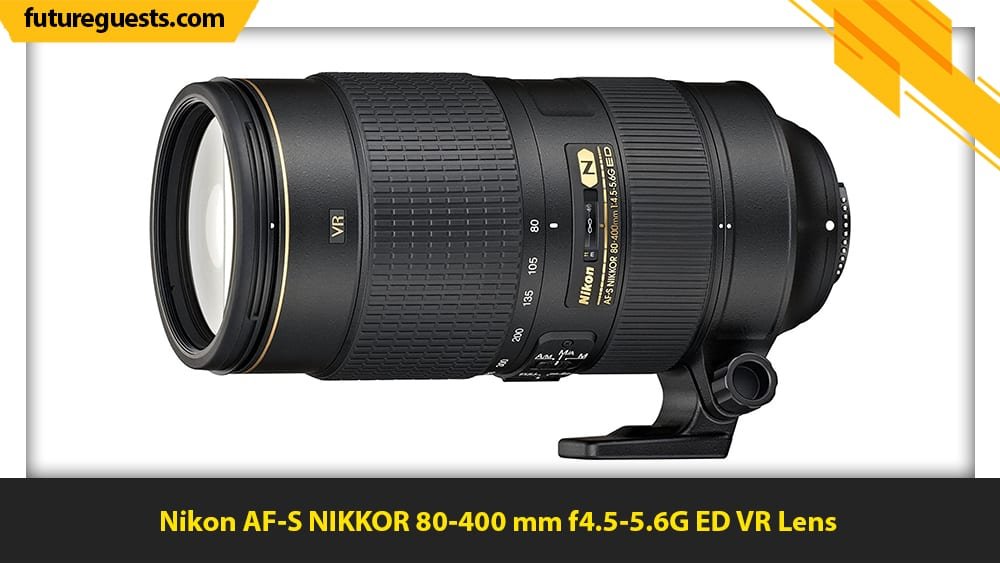

The Nikon AF-S NIKKOR 80-400 mm f/4.5-5.6G ED VR lens would be a great choice for sports photography due to its highly advanced optical design, versatile focal length range and maximum aperture.
The Nikon AF-S NIKKOR 80-400 mm f/4.5-5.6G ED VR lens is designed for FX-format F-mount cameras. However, it is also possible to use it with DX camera formats. In this way the equivalent focal length would be 120-600 mm.
The dimension of this lens is 95.5 × 203 mm and it weighs 3.46 lbs.
It was first introduced in 2013.
Features & Benefits:
- One super extra-low dispersion element and four extra-low dispersion elements reduce the distortions and chromatic aberrations.
- The Nano Crystal and Super Integrated coatings have been applied to individual elements to reduce flare and ghosting.
- The Silent Wave Motor technology used in the autofocusing system can perform very fast and near silent autofocusing. The manual focus override option also provides more control over the focus position.
- A great image stabilization technology able to reduce the shake up to four shutter speed stops. This enables effective handhold shooting with great image sharpness.
- Dust- and moisture- resistant
Pros
- Really fast and quiet autofocus performance
- Weather resistant
- Great image stabilization system
Cons
- Sharpness issues around 400 mm
- Less vibration reduction around 400 mm
Expert Opinion:
Choosing the Best Lenses for Sports Photography — Buyers Guide
Finding the best lenses for sports photography could be tricky as there are so many different models in the market and each model has different features.
You really need to know your specific purpose for shooting photos. For example, if you want to shoot professionally for a magazine or newspaper or you just wish to shoot for fun.
I have already reviewed 13 best lenses for sports photography for Canon and Nikon cameras.
Here, I have prepared a comprehensive Buyers Guide to understand the definition of various lens terminology, and how to properly select your own specific lenses when you need to choose one for your different camera models.
1. What is the best focal length for sports photography lenses?
The focal length of each lens is the most important and primary feature you need to pay attention to. The focal length basically means how close you can get to an object using your lens.
The higher the focal length, the closer you can get to an object and the sharper photos you can take from remote objects. The focal length is described in millimeters.
For sports photography, typically a focal length within 50 to 400 mm would be ideal.
You can also use teleconverters to increase the reach of your lens.
2. What maximum aperture do you need for sports photography?
The maximum aperture is one of the most important features for sports photography.
It determines the amount of light passing through the lens. So, it can make your photos appear darker or brighter.
The maximum aperture of a lens is stated in f/stops. The higher the aperture, the less light can pass through the lens opening.
If you want to shoot photos of indoor sports like volleyball, then you should go for lenses with lower maximum aperture.
It is because the amount of light in indoor places is always less than the outdoor light.
This will allow you to use all the light available in the closed environment to prevent your images from appearing dark.
Also, lower maximum aperture would allow you create photos with beautifully blurred background in order to emphasize on an object.
On the other hand, the lenses with higher aperture values deliver sharper photos with shallower focus effect.
3. Full-Frame or APS-C Lens?
When a lens is designed for full-frame cameras, it means that it has a 35 mm film frame. On the other hand, APS-C film frames measure 16.7 x 30.2 mm. Therefore, APS-C lenses have smaller frames.
If you mount a full-frame lens on an APS-C camera, then you will get a crop factor.
This means that the object you are shooting will be magnified to produce an image with full-frame size.
Different camera models have different crop factors. The crop factor of Canon and Nikon are 1.6x and 1.5x, respectively.
Moreover, by mounting full-frame lenses on APS-c cameras you may introduce more flare into your images.
You can also mount APS-C lenses on full-frame cameras. This way, you will be able to capture more field of view; however, this might also result in a black circle around your image.
Also, note that APS-C lenses are usually cheaper than full-frame ones. So, if the price is an important factor to you, you can try this method.
My opinion is that using the APS-C lenses on full-frame cameras or using the full-frame lenses on APS-C cameras could be very tricky.
So, I suggest the full-frame lenses to be used with full-frame cameras and the APS-C lenses with the APS-C cameras.
If you decide otherwise, make sure to check the compatibility of your camera with the lens you choose.
Nikon uses the term FX-format for its full-frame lenses and cameras. The dimension is 36 × 24 mm, which is almost equal to the Canon’s full-frames.
Also, for the APS-C lenses and cameras, Nikon uses the term DX-format. For these types of cameras, the frame size is 24 × 16 mm.
You can choose either the full-frame or APS-C lenses for sports photography considering your camera model.
4. Autofocus Speed for sports photography
Autofocus speed is a very important factor for sports photography. This is because in sports photography, you are mostly needed to capture very critical moments and so you need to be quick.
Canon uses the Ultrasonic Motor technology for its lenses to enhance autofocus speed. The is indicated by the word USM on the lens side.
On the other hand, Nikon takes the advantage of the Silent Wave Motor (SWM) technology for this purpose. The Nikon’s SWM lenses are super quiet and almost silent.
So, if this is an important factor for you, I recommend to choose a lens from Nikon.
5. Image Stabilization System
Another important factor to consider in sports photography is the image stabilization system of the lens.
The image stabilization and shake reduction capability of the lenses are stated in number of shutter speed stops. The higher the value, the better the lens in reducing shake.
You need the image stabilization system for sports photography because the sport players and objects are usually fast-moving and are not still.
By using the image stabilization feature of a lens, you can get sharp images of moving objects.
Also, a good image stabilization system will help you shoot at faster shutter speeds.
The image stabilization capabilities of the Canon lenses are stated by IS on its side and the Nikon uses the letters VR to specify this capability.
Make sure to turn the IS mode OFF when you mount your camera on a tripod or monopod, otherwise the image stabilization system of the camera will interfere with that of the lens leading to blurred images.
6. Zoom or Prime Lenses?
Zoom lenses are basically those with variable focal lengths. On the other hand, prime lenses have fixed focal lengths.
If you see that the focal length of a lens is written as a range on its side, it would mean you are looking at a zoom lens.
You can choose between either prime or zoom lenses for sports photography; however, remember that the prime lenses usually have higher image quality compared to the zoom lenses.
A zoom lens with exactly the same image quality of a prime lens is more expensive because it has more moving parts inside.
7. Use of Teleconverters for sports photography
Teleconverters can be used with lenses to increase their reach. In other words, they can increase the focal length of your lens.
Use of teleconverters could negatively affect the autofocus speed.
If not chosen carefully, they can also decrease the quality of images by reducing the sharpness.
Depending on the application and your needs, you can decide whether to use a teleconverter or not for sports photography.
However, you shouldn’t neglect the lenses’ focal length and depend totally on teleconverters.
8. Weather Resistance
If you are planning to shoot outdoor sport matches, then you should carefully pay attention to the weather resistance feature of a lens.
Because sometimes matches are held in rainy, snowy or windy weather conditions and if your lens is not water-resistant, this would damage your expensive lens for sure.
Dust- and water-resistant means that some rubber materials are used in the structure of the lens to completely seal it against dust and water.
Remember that this is different from being water-proof. Using water-proof lenses, you can take photos underwater. However, you can’t immerse the weather-resistant lenses into the water.
9. Chromatic Aberration
The chromatic aberration is fringes of green and red on the sharp edges of the photographed object. This happens due to incorrect refraction of the colors by camera lens.
For sports photography and all kinds of other photography, it is important to choose a lens with lower distortion and chromatic aberration.
Especially if you are planning to take photos in outdoor sport matches, you had better spend more money for this feature of your lens to get best results.
Sometimes expensive lenses have less distortions and chromatic aberration.
However, this is not a general rule. You may find a lens with the same image quality of an expensive one for cheaper price. So, pay attention to what lens you buy.
10. Sports lenses for Mirrorless Cameras
Mirrorless cameras are type of cameras that don’t have the reflex mirror and optical viewfinder, instead they use digital display system.
They were introduced for the first time in 2004. Therefore, the number of lenses for mirrorless cameras is a lot less than the digital DSLRs.
But don’t worry. Mirrorless cameras are rapidly becoming more and more popular due to the benefits they provide.
They are lighter, more compact and faster than most of the digital DSLRs.
If you have a mirrorless camera, you can choose a lens for sports photography from the limited number of mirrorless lenses available.
Or you can choose a DSLR lens and attach it to your camera with an adaptor. Although you may experience some issues in the second conditions, but I think it is worth the variety it brings along.
Conclusions
In this article, the 13 best Canon & Nikon lenses for sports photography were reviewed. Also, a buyers guide was provided at the end to help you choose your own best lens.
As I explained above, many factors need to be taken into account to choose a good lens for your specific need.
The most important parameter to take into account is the focal length range. The focal length suitable for sports photography should be something between 50 to 400 mm.
The second most important feature of a lens for sports photography is the autofocus speed.
You want to capture the photos of dramatic moments in sport matches, right? Then pay more attention to this feature if you want to shoot quickly in such moments.
The third most important feature is the image stabilization system of the lens.
The reason is that in sports matches, the players or objects are usually all fast-moving and if you want to get a sharp photo of a fast-moving object, you need a good image stabilization system.
Based on your specific needs you might also pay attention to other features like maximum aperture, weather resistance and optical design.
Decide whether you want to shoot photos of indoor matches or outdoor matches or both. Keep in mind that even the most expensive lenses don’t guarantee the right performance for you.
The best lens for sports photography is defined based on your needs.
Here are my suggestions:
- Among the 13 best lenses I introduced for sports photography, I recommend the Canon EF 400 mm f/2.8L IS II USM lens for Canon cameras and the Nikon AF-S NIKKOR 300 mm f/2.8G ED VR II lens for Nikon cameras, if the price is not an issue for you.
- If the price does indeed matter, I recommend Canon EF 70-200 mm f/2.8L USM lens for Canon cameras and Nikon AF-S NIKKOR 70-200 mm f/2.8E FL ED VR lens for Nikon cameras.
- For mirrorless Canon cameras, I suggest Canon EF-M 18-55 mm f3.5-5.6 IS STM lens.
For mirrorless Nikon cameras, Nikon 1 NIKKOR 30-110 mm f/3.8-5.6 VR lens is recommended.
Recent Camera Lens Posts
-

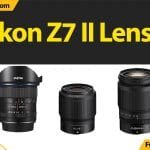 Best Lenses for Nikon Z7 II (2021): Reviews & Buyers GuideMarch 13, 2021/0 Comments
Best Lenses for Nikon Z7 II (2021): Reviews & Buyers GuideMarch 13, 2021/0 Comments -
![Best Lenses for Canon EOS M50 Mark II [2021]: Reviews & Buyer’s Guide](data:image/gif;base64,R0lGODlhAQABAAAAACH5BAEKAAEALAAAAAABAAEAAAICTAEAOw==)
![Best Lenses for Canon EOS M50 Mark II [2021]: Reviews & Buyer’s Guide](https://futureguests.com/wp-content/uploads/2021/01/Canon-EOS-M50-Mark2-Lenses-150x150.jpg)
-

 Best Lenses for Sony a7C (2021): Reviews & Buyers GuideOctober 25, 2020/
Best Lenses for Sony a7C (2021): Reviews & Buyers GuideOctober 25, 2020/ -

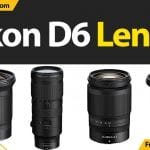 Best Lenses for Nikon D6 (2021): Reviews & Buyers GuideOctober 12, 2020/
Best Lenses for Nikon D6 (2021): Reviews & Buyers GuideOctober 12, 2020/ -

 Best Lenses for Nikon Z5 (2021): Reviews & Buyers GuideOctober 9, 2020/
Best Lenses for Nikon Z5 (2021): Reviews & Buyers GuideOctober 9, 2020/ -

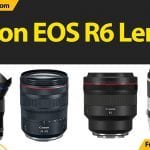 Best Lenses for Canon EOS R6 Reviewed | Buyers GuideAugust 30, 2020/
Best Lenses for Canon EOS R6 Reviewed | Buyers GuideAugust 30, 2020/ -

 Best Lenses for Canon EOS R5 Reviewed | Buyers GuideAugust 30, 2020/
Best Lenses for Canon EOS R5 Reviewed | Buyers GuideAugust 30, 2020/ -


-

 Best Lenses for Fujifilm X-T4: Reviews & Buyers GuideMarch 12, 2020/
Best Lenses for Fujifilm X-T4: Reviews & Buyers GuideMarch 12, 2020/ -









